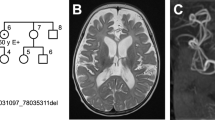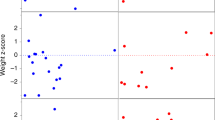Abstract
Duplications in Xq28 involving MECP2 have been described in patients with severe mental retardation, infantile hypotonia, progressive spasticity, and recurrent infections. However, it is not yet clear to what extent these and accompanying symptoms may vary. In addition, the frequency of Xq28 duplications including MECP2 has yet to be determined in patients with unexplained X-linked mental retardation and (fe)males with severe encephalopathy. In this study, we used multiplex ligation-dependent probe amplification to screen Xq28 including MECP2 for deletions and duplications in these patient cohorts. In the group of 283 patients with X-linked mental retardation, we identified three Xq28 duplications including MECP2, which suggests that approximately 1% of unexplained X-linked mental retardation may be caused by MECP2 duplications. In addition, we found three additional MECP2 duplications in 134 male patients with mental retardation and severe, mostly progressive, neurological symptoms, indicating that the mutation frequency could be as high as 2% in this group of patients. In 329 female patients, no Xq28 duplications were detected. In total, we assessed 13 male patients with a MECP2 duplication from six unrelated families. Moderate to severe mental retardation and childhood hypotonia was noted in all patients. The majority of the patients also presented with absent speech, seizures, and progressive spasticity as well as ataxia or an ataxic gait and cerebral atrophy, two previously unreported symptoms. We propose to implement DNA copy number testing for MECP2 in the current diagnostic testing in all males with moderate to severe mental retardation accompanied by (progressive) neurological symptoms.
Similar content being viewed by others

Log in or create a free account to read this content
Gain free access to this article, as well as selected content from this journal and more on nature.com
or
References
Kleefstra T, Brunner HG, Amiel J et al: Loss-of-function mutations in euchromatin histone methyl transferase 1 (EHMT1) cause the 9q34 subtelomeric deletion syndrome. Am J Hum Genet 2006; 79: 370–377.
Van Esch H, Bauters M, Ignatius J et al: Duplication of the MECP2 region is a frequent cause of severe mental retardation and progressive neurological symptoms in males. Am J Hum Genet 2005; 77: 442–453.
Ariani F, Mari F, Pescucci C et al: Real-time quantitative PCR as a routine method for screening large rearrangements in Rett syndrome: Report of one case of MECP2 deletion and one case of MECP2 duplication. Hum Mutat 2004; 24: 172–177.
del Gaudio D, Fang P, Scaglia F et al: Increased MECP2 gene copy number as the result of genomic duplication in neurodevelopmentally delayed males. Genet Med 2006; 8: 784–792.
Friez MJ, Jones JR, Clarkson K et al: Recurrent infections, hypotonia, and mental retardation caused by duplication of MECP2 and adjacent region in Xq28. Pediatrics 2006; 118: e1687–e1695.
Meins M, Lehmann J, Gerresheim F et al: Submicroscopic duplication in Xq28 causes increased expression of the MECP2 gene in a boy with severe mental retardation and features of Rett syndrome. J Med Genet 2005; 42: e12.
Smyk M, Obersztyn E, Nowakowska B et al: Different-sized duplications of Xq28, including MECP2, in three males with mental retardation, absent or delayed speech, and recurrent infections. Am J Med Genet B Neuropsychiatr Genet 2008; 147B: 799–806.
Sanlaville D, Prieur M, de Blois MC et al: Functional disomy of the Xq28 chromosome region. Eur J Hum Genet 2005; 13: 579–585.
Miller SA, Dykes DD, Polesky HF : A simple salting out procedure for extracting DNA from human nucleated cells. Nucleic Acids Res 1988; 16: 1215.
Lugtenberg D, de Brouwer AP, Kleefstra T et al: Chromosomal copy number changes in patients with non-syndromic X-linked mental retardation detected by array CGH. J Med Genet 2006; 43: 362–370.
Rosenberg EH, Almeida LS, Kleefstra T et al: High prevalence of SLC6A8 deficiency in X-linked mental retardation. Am J Hum Genet 2004; 75: 97–105.
Jouet M, Rosenthal A, Armstrong G et al: X-linked spastic paraplegia (SPG1), MASA syndrome and X-linked hydrocephalus result from mutations in the L1 gene. Nat Genet 1994; 7: 402–407.
Carrel L, Willard HF : X-inactivation profile reveals extensive variability in X-linked gene expression in females. Nature 2005; 434: 400–404.
Robertson SP, Twigg SR, Sutherland-Smith AJ et al: Localized mutations in the gene encoding the cytoskeletal protein filamin A cause diverse malformations in humans. Nat Genet 2003; 33: 487–491.
Fox JW, Lamperti ED, Eksioglu YZ et al: Mutations in filamin 1 prevent migration of cerebral cortical neurons in human periventricular heterotopia. Neuron 1998; 21: 1315–1325.
Huttenlocher PR, Taravath S, Mojtahedi S : Periventricular heterotopia and epilepsy. Neurology 1994; 44: 51–55.
D'Adamo P, Menegon A, Lo Nigro C et al: Mutations in GDI1 are responsible for X-linked non-specific mental retardation. Nat Genet 1998; 19-6: 134–139.
Madrigal I, Rodriguez-Revenga L, Badenas C et al: MLPA as first screening method for the detection of microduplications and microdeletions in patients with X-linked mental retardation. Genet Med 2007; 9: 117–122.
Briellmann RS, Wellard RM, Jackson GD : Seizure-associated abnormalities in epilepsy: evidence from MR imaging. Epilepsia 2005; 46: 760–766.
Eichler EE, Budarf ML, Rocchi M et al: Interchromosomal duplications of the adrenoleukodystrophy locus: a phenomenon of pericentromeric plasticity. Hum Mol Genet 1997; 6: 991–1002.
Horvath JE, Schwartz S, Eichler EE : The mosaic structure of human pericentromeric DNA: a strategy for characterizing complex regions of the human genome. Genome Res 2000; 10: 839–852.
Bauters M, Van EH, Friez MJ et al: Non-recurrent MECP2 duplications mediated by genomic architecture-driven DNA breaks and break-induced replication repair. Genome Res 2008; 18: 847–858.
de Brouwer AP, Yntema HG, Kleefstra T et al: Mutation frequencies of X-linked mental retardation genes in families from the EuroMRX consortium. Hum Mutat 2007; 28: 207–208.
Acknowledgements
We thank the members of the families investigated for their invaluable contribution to this study.
Author information
Authors and Affiliations
Corresponding author
Rights and permissions
About this article
Cite this article
Lugtenberg, D., Kleefstra, T., Oudakker, A. et al. Structural variation in Xq28: MECP2 duplications in 1% of patients with unexplained XLMR and in 2% of male patients with severe encephalopathy. Eur J Hum Genet 17, 444–453 (2009). https://doi.org/10.1038/ejhg.2008.208
Received:
Revised:
Accepted:
Published:
Issue date:
DOI: https://doi.org/10.1038/ejhg.2008.208
Keywords
This article is cited by
-
Genetic analysis of a pedigree with MECP2 duplication syndrome in China
BMC Medical Genomics (2024)
-
Duplication within two regions distal to MECP2: clinical similarity with MECP2 duplication syndrome
BMC Medical Genomics (2023)
-
IRAK1 Duplication in MECP2 Duplication Syndrome Does Not Increase Canonical NF-κB–Induced Inflammation
Journal of Clinical Immunology (2023)
-
A brief history of MECP2 duplication syndrome: 20-years of clinical understanding
Orphanet Journal of Rare Diseases (2022)
-
Syndromale Erkrankungen mit Epilepsie bei MECP2-Mutationen
Zeitschrift für Epileptologie (2022)


